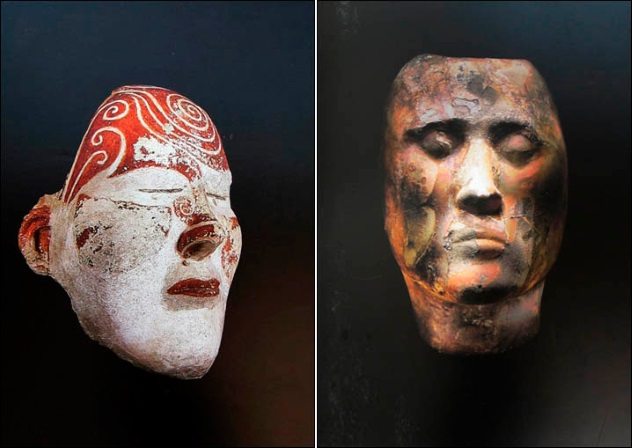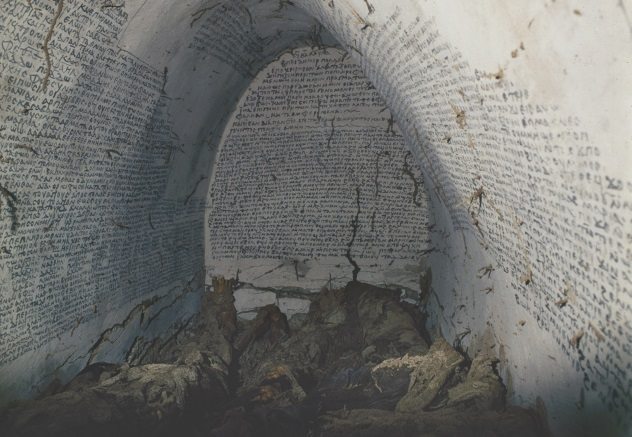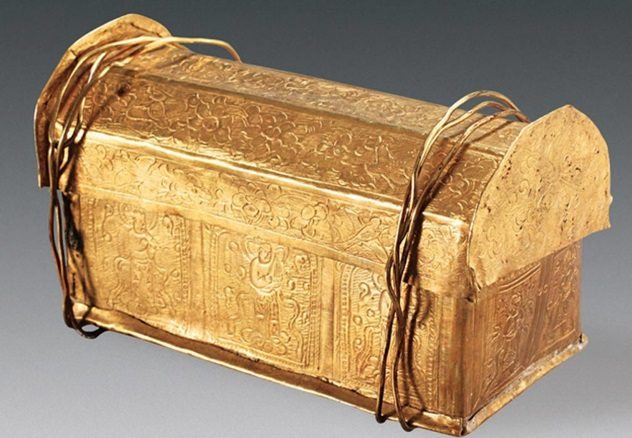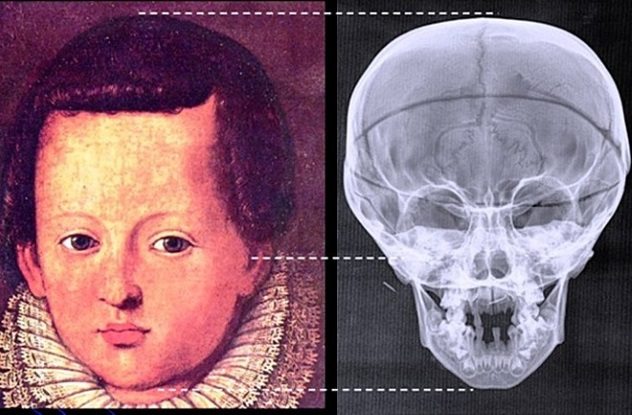(单词翻译:单击)
Crypts contain more than just human remains. These subterranean skeleton sanctuaries hold secrets. Artistic masterpieces, relics, and even evidence of disease have been recovered from crypts. These mysterious artifacts tantalize archaeologists with the window they provide into the deceased's world. Many more enigmas await discovery in the shadows of crypts.
地窖里不只留存着人类的尸骨。这些深藏地下的葬身之地还保留着秘密。在地窖中,我们发现了艺术杰作、遗迹甚至关于疾病的证据。这些神秘的作品吊足了考古学家的胃口,通过这扇窗户,他们可以了解亡者的世界。而地窖中还有更多谜题等待我们去揭开。
10.Siberian Death Masks
10.西伯利亚人的尸体面模

In 2015, researchers found 20 death masks in an ancient crypt in Siberia's Kemerovo region. The tomb belonged to the enigmatic Tashtyk people, warriors who controlled large portions of Siberia between 300 BC and AD 500. The crypt was dug into the ground, surrounded by a stone wall, and covered with a log roof. The massive burial pit took two years to excavate.
2015年,研究人员在西伯利亚克麦罗沃地区的一座古老地窖内发现了20个尸体面模。这座陵墓属于神秘的塔施提克人,他们曾于公元前300年到公元500年之间控制着西伯利亚的大部分地区。这座墓室深埋地下,四周是石墙,顶上覆盖着木质屋顶。研究人员花了两年时间才挖掘出这座庞大的墓坑。
Archaeologists discovered the remains of 30 people who had been cremated and placed inside dummy bodies made of fabric and leather. "Death masks" of gypsum provided the dummies' faces. Some were surprised to find that the Tashtyk death masks have stereotypically European features. The remains of children were discovered outside the tomb. None of the youngsters had death masks.
考古学家发现了30具经过火葬的遗骸,装在布和皮革制成的假体中。假体的面部是由石膏制作而成的“尸体面模”。令人惊讶的是,塔施提克人的尸体面模在外形上具有欧洲人的特征。陵墓外还发现了儿童的遗骸。所有青少年都没有戴面模。
Gypsum is a soft mineral, so many of the masks are in fragments. However, experts believe they may be able to piece together the broken faces.
石膏是一种柔软的矿物质,因此很多面具都已破碎。但是,专家认为这些破碎的面具可以被重新拼凑起来。
9.Seven Magical Mummies
9.7具神秘的干尸

In 2009, archaeologists discovered seven mummies in a 900-year-old crypt with walls covered in magical inscriptions. The naturally preserved remains came from deep within a monastery in Old Dongola, the capital of the medieval kingdom of Makuria in modern-day Sudan. The crypt contained the remains of seven males, all over age 40. The burial chamber was sealed with bricks and mud mortar.
2009年,考古学家在一座有900年历史的地窖中发现了七具干尸,地窖的墙壁上还刻满了神秘碑文。这些自然保存下来的遗骸来自古栋古拉的一座修道院深处,栋古拉是中世纪时马库里亚——位于今天的苏丹——的首府。这座地窖内存放了七具遗骨,死亡时的年龄都在40岁以上。墓室由砖块和泥灰浆密封。
Black ink inscriptions in Sahidic Coptic and Greek cloak the crypt's whitewashed walls. There are Gospel excerpts along with magical names and symbols, which are believed to have been intended to protect the dead from malicious forces. Tradition held that the recently deceased were in a state of flux and were vulnerable before they faced judgment.
地窖白色的墙壁上用黑墨水写满了埃及古语和希腊语的碑文。还有福音书的节选以及神秘的名字与符号,有人认为这是为了保护死者免遭邪恶力量的侵袭。传说刚刚去世的人会处在不稳定的状态中,在灵魂受审之前很容易受到侵害。
The crypt was first located in 1933, but excavations would not occur until over 70 years later. Experts believe one of the mummies might be Archbishop Georgios, one of the most powerful Christians in Makuria.
这座地窖最早于1933年被发现,但是直到70多年后才开始挖掘。专家认为其中一具干尸是总主教乔治斯,他是马库里亚最有权势的基督徒。
8.The Buddha's Skull
8.佛陀的头盖骨

Archaeologists believe they may have found a piece of the Buddha's skull in a 1,000-year-old chest discovered in a crypt beneath Grand Bao'en Temple in Nanjing, China. The stupa not only contained what might be the skull of the Buddha, but it was filled with the bones of other Buddhist saints. The box was constructed of carved sandalwood, covered in silver and gold, and encrusted with crystal, glass, lapis lazuli, and agate. Inscriptions reveal that the stupa was made during Emperor Zhenzong's reign (AD 997–1022) during the Song Dynasty.
考古学家认为,他们可能在中国南京报恩寺地窖内一只有千年历史的箱子里发现了一片佛陀的头盖骨。这座佛塔内不仅有疑似佛陀头盖骨的东西,还有其他佛教圣人的尸骨。箱子由檀香木雕刻而成,以金银覆盖表面,并镶有水晶、玻璃、天青石和玛瑙。题字显示,舍利塔建造于于宋朝宋真宗年间(公元997-1022年)。
The stupa was nestled within an iron box, which in turn was housed in a stone chest. According to tradition, when the Buddha was cremated, King Ashoka of India decided to divide the saint's body into 84,000 equal shares. China received 19 of these, including the Buddha's parietal bone. The remains were originally housed in another temple, which was destroyed in warfare 1,400 years ago.
舍利塔被安放在一只铁盒中,铁盒被放置在一口石箱子里。据说佛陀被火葬之后,阿育王决定将他的身体平均分成84000块。中国拿到了其中的19块,包括佛陀的顶骨。这些遗骨最初保存在另一座寺庙中,但那座寺庙在1400年前被毁。
7.Cancer Mummy
7.患癌干尸

In 1995, archaeologists unearthed an 18th-century Hungarian mummy that is revolutionizing the study of cancer. The naturally preserved remains were discovered in the sealed crypt of a Dominican church in Vac. Roughly 260 mummified remains were found in total. A team of Israeli researchers tested the corpses to see if they were carriers of cancer-causing genes. In one individual, they discovered a mutation in the APC gene, which is known to cause an increased risk of colon cancer.
1995年,考古学家发掘出一具18世纪的匈牙利干尸,这具干尸引发了肿瘤研究的革命。这具自然形成的干尸被存放在一座多米尼加教堂的封闭地窖中。此次总共发现了约260具干尸。来自以色列的一个研究团队对尸体进行了检测,以确定它们是否携带致癌基因。研究人员在其中一具尸体身上发现了APC基因突变,我们知道,这种突变会提高结肠癌的风险。
What the findings suggest is that a predisposition existed before the disease became a serious health issue. Today, colorectal cancer is the third most common form of cancer. Most consider it to be a modern disease that results from a lack of activity, processed foods, and a longer life expectancy. The presence of the mutated gene in other mummies would indicate that genetic inheritance might be even more important than environment.
这些发现说明,在肿瘤成为严重的健康问题之前,就已经有人患病。今天,结肠癌是第三大常见癌症。大多数人认为这是一种由于缺乏运动、食用加工食品与长寿所引发的现代疾病。但是,在其他干尸身上发现的突变基因说明,基因遗传可能比环境的作用更加重要。
6.Secret Medici Crypt
6.神秘的美第奇地窖

In 2004, archaeologists discovered a secret crypt belonging to Italy's powerful Medici family. During an earlier exploration of a known Medici crypt, experts were shocked to discover that the grave of the last Medici, Grand Duke Gian Gastone, was empty. In an attempt to find the missing corpse, they discovered a clandestine chamber behind the main altar of Florence's Church of San Lorenzo. Researchers lifted a stone slab to reveal steps leading to the hidden crypt.
2004年,考古学家发现了一个属于意大利名门望族——美第奇家族的神秘地窖。此前在发掘一座美第奇家族的地窖时,专家惊讶地发现,家族最后一位成员吉安·加斯托内大公的坟墓是空的。为了寻找失踪的尸体,他们在圣洛伦索的佛罗伦萨教堂主祭坛后面发现了一间密室。研究人员搬开石板,发现了通往隐蔽地窖的台阶。
The secret chamber contained one adult coffin, which held Gastone, and eight child coffins. All of the children's bones showed signs of rickets. This is likely due to a lack of vitamin D in their diet. Being sheltered indoors under thick, pale makeup didn't help their absorption of this necessary element. Researchers cannot identify some of the dead youngsters. It is likely that at least some of them are illegitimate children.
这间密室内有一具成年人的棺材,其中安放着加斯托内和八个儿童的尸体。这些儿童的尸骨表明他们都患有佝偻病。病因可能是他们的饮食中缺少维生素D,而且长期深居室内,不利于吸收这种必要的元素。研究人员尚无法辨认其中一些年轻死者,至少有一些是私生子。


